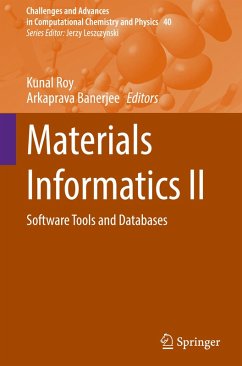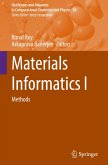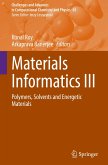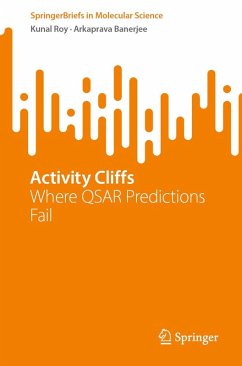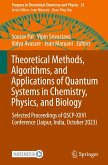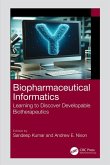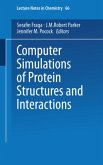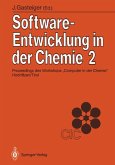Materials Informatics II
Software Tools and Databases
Herausgegeben:Roy, Kunal; Banerjee, Arkaprava
Materials Informatics II
Software Tools and Databases
Herausgegeben:Roy, Kunal; Banerjee, Arkaprava
- Gebundenes Buch
- Merkliste
- Auf die Merkliste
- Bewerten Bewerten
- Teilen
- Produkt teilen
- Produkterinnerung
- Produkterinnerung
This contributed volume explores the application of machine learning in predictive modeling within the fields of materials science, nanotechnology, and cheminformatics. It covers a range of topics, including electronic properties of metal nanoclusters, carbon quantum dots, toxicity assessments of nanomaterials, and predictive modeling for fullerenes and perovskite materials. Additionally, the book discusses multiscale modeling and advanced decision support systems for nanomaterial risk management, while also highlighting various machine learning tools, databases, and web platforms designed to…mehr
Andere Kunden interessierten sich auch für
![Materials Informatics I Materials Informatics I]() Materials Informatics I189,99 €
Materials Informatics I189,99 €![Materials Informatics III Materials Informatics III]() Materials Informatics III151,99 €
Materials Informatics III151,99 €![Activity Cliffs Activity Cliffs]() Kunal RoyActivity Cliffs38,99 €
Kunal RoyActivity Cliffs38,99 €![Theoretical Methods, Algorithms, and Applications of Quantum Systems in Chemistry, Physics, and Biology Theoretical Methods, Algorithms, and Applications of Quantum Systems in Chemistry, Physics, and Biology]() Theoretical Methods, Algorithms, and Applications of Quantum Systems in Chemistry, Physics, and Biology168,99 €
Theoretical Methods, Algorithms, and Applications of Quantum Systems in Chemistry, Physics, and Biology168,99 €![Biopharmaceutical Informatics Biopharmaceutical Informatics]() Biopharmaceutical Informatics177,99 €
Biopharmaceutical Informatics177,99 €![Computer Simulations of Protein Structures and Interactions Computer Simulations of Protein Structures and Interactions]() Serafin FragaComputer Simulations of Protein Structures and Interactions39,99 €
Serafin FragaComputer Simulations of Protein Structures and Interactions39,99 €![Software-Entwicklung in der Chemie 2 Software-Entwicklung in der Chemie 2]() Software-Entwicklung in der Chemie 277,99 €
Software-Entwicklung in der Chemie 277,99 €-
-
-
This contributed volume explores the application of machine learning in predictive modeling within the fields of materials science, nanotechnology, and cheminformatics. It covers a range of topics, including electronic properties of metal nanoclusters, carbon quantum dots, toxicity assessments of nanomaterials, and predictive modeling for fullerenes and perovskite materials. Additionally, the book discusses multiscale modeling and advanced decision support systems for nanomaterial risk management, while also highlighting various machine learning tools, databases, and web platforms designed to predict the properties of materials and molecules. It is a comprehensive guide and a great tool for researchers working at the intersection of machine learning and material sciences.
Produktdetails
- Produktdetails
- Challenges and Advances in Computational Chemistry and Physics 40
- Verlag: Springer / Springer Nature Switzerland / Springer, Berlin
- Artikelnr. des Verlages: 978-3-031-78727-0
- Seitenzahl: 316
- Erscheinungstermin: 15. März 2025
- Englisch
- Abmessung: 241mm x 160mm x 22mm
- Gewicht: 641g
- ISBN-13: 9783031787270
- ISBN-10: 3031787277
- Artikelnr.: 71957834
- Herstellerkennzeichnung
- Springer-Verlag GmbH
- Tiergartenstr. 17
- 69121 Heidelberg
- ProductSafety@springernature.com
- Challenges and Advances in Computational Chemistry and Physics 40
- Verlag: Springer / Springer Nature Switzerland / Springer, Berlin
- Artikelnr. des Verlages: 978-3-031-78727-0
- Seitenzahl: 316
- Erscheinungstermin: 15. März 2025
- Englisch
- Abmessung: 241mm x 160mm x 22mm
- Gewicht: 641g
- ISBN-13: 9783031787270
- ISBN-10: 3031787277
- Artikelnr.: 71957834
- Herstellerkennzeichnung
- Springer-Verlag GmbH
- Tiergartenstr. 17
- 69121 Heidelberg
- ProductSafety@springernature.com
Dr. Kunal Roy is Professor & Ex-Head in the Department of Pharmaceutical Technology, Jadavpur University, Kolkata, India. He has been a recipient of the Commonwealth Academic Staff Fellowship (University of Manchester, 2007) and Marie Curie International Incoming Fellowship (University of Manchester, 2013) and a former visiting scientist of Istituto di Ricerche Farmacologiche "Mario Negri" IRCCS, Milano, Italy. The field of his research interest is Quantitative structure-activity Relationship (QSAR) and Molecular Modeling with applications in Drug Design, Property Modeling, and Predictive Ecotoxicology. Dr. Roy has published more than 380 research articles in refereed journals (current SCOPUS h index 55; total citations to date more than 15000). He has also co-authored two QSAR-related books (Academic Press and Springer), edited six QSAR books (Springer, Academic Press, and IGI Global), and published more than ten book chapters. Dr. Roy is the Co-Editor-in-Chief of Molecular Diversity (Springer Nature) and an Associate Editor of the Computational and Structural Biotechnology Journal (Elsevier). Dr. Roy serves on the Editorial Boards of several International journals, including (1) European Journal of Medicinal Chemistry (Elsevier); (2) Journal of Molecular Graphics and Modelling (Elsevier); (3) Chemical Biology and Drug Design (Wiley); and (4) Expert Opinion on Drug Discovery (Informa). Apart from this, Prof. Roy is a regular reviewer for QSAR papers in the journals like Chemosphere (Elsevier), Journal of Hazardous Materials (Elsevier), Ecotoxicology and Environmental Safety (Elsevier), Journal of Chemical Information and Modeling (ACS), ACS Omega (ACS), RSC Advances (RSC), Molecular Informatics (Wiley), SAR and QSAR in Environmental Research (T&F), etc. Prof. Roy has been recipient of several awards including AICTE Career Award (2003-04), DST Fast Track Scheme for Young Scientists (2005), Bioorganic and Medicinal Chemistry Most Cited Paper 2003-2006, 2004-2007 and 2006-2009 Awards from Elsevier, The Netherlands, Bioorganic and Medicinal Chemistry Letters Most Cited Paper 2006-2009 Award from Elsevier, The Netherlands, Professor R. D. Desai 80th Birthday Commemoration Medal & Prize (2017) from Indian Chemical Society, etc. Prof. Roy has been a participant in the EU funded projects nanoBRIDGES and IONTOX apart from several national Government funded projects (UGC, AICTE, CSIR, ICMR, DBT, DAE). Prof. Roy has recently been placed in the list of the World's Top 2% science-wide author database (2023) (World rank 55 in the subfield of Medicinal & Biomolecular Chemistry) (Ioannidis, John P.A. (2024), "August 2024 data-update for "Updated science-wide author databases of standardized citation indicators", Elsevier Data Repository. Arkaprava Banerjee is a researcher (funded by the Life Sciences Research Board, DRDO, Govt. of India) working at the Drug Theoretics and Cheminformatics Laboratory, Department of Pharmaceutical Technology, Jadavpur University, Kolkata. Mr. Banerjee has twenty-two research articles published in reputed journals and two book chapters with overall citations of 392 and an h-index of 11 (Scopus). His ORCID identifier is 0000-0001-8468-0784, His expertise lies in similarity-based cheminformatic approaches like Read-Across and Read-Across Structure-Activity Relationship (RASAR), a novel method that combines the concept of QSAR and Read-Across. Mr. Banerjee is also a Java programmer who has developed various cheminformatic tools based on QSAR, Read-Across, and RASAR, and the tools are freely available from the DTC Laboratory Supplementary Website. He received the Prof. Anupam Sengupta Bronze Medal from Jadavpur University for securing the highest marks in Pharmaceutical Chemistry in the MPharm Examination. He has also received a special diploma awarded by the Institute of Biomedical Chemistry, Moscow, Russia, and the ASCCT Travel Award from the American Society for Cellular and Computation Toxicology. Together with Prof. Kunal Roy, he has been one of the first researchers to develop quantitative models using similarity and error-based descriptors (quantitative/classification Read-Across Structure-Activity Relationship: q-RASAR/c-RASAR models) with applications in drug design, materials science, and property modeling. Recently, he coauthored a book on "q-RASAR," which was published by Springer.
Part 1. Introduction.- Introduction to Machine Learning for Predictive Modeling I.- Introduction to Machine Learning for Materials Property Modeling.- Part 2. Cheminformatic and Machine Learning Models for Nanomaterials.- Machine learning models to study electronic properties of metal nanoclusters.- Applications of Machine Learning Predictive Modeling for Carbon Quantum Dots.- Assessing the toxicity of quantum dots in healthy and tumoral cells with ProtoNANO, a platform of nano-QSAR models to predict the toxicity of inorganic nanomaterials.- Applications of predictive modeling for fullerenes.- Computational Analysis of Perovskite Materials AlXY3 (X = Cu, Mn; Y = Br, Cl, F) invoking the DFT Method.- Applications of predictive modeling for dye-sensitized solar cells (DSSCs).- Introduction to multiscale modeling for One Health approaches.- DIAGONAL Decision Support System (DSS) for Advanced Nanomaterial Risk Management powered by Enalos Cloud Platform.- Part 3. Software Tools and Databases for Applications in Materials Science.- Machine Learning algorithms, tools, and databases for applications in Materials Science.- Machine Learning-Driven Web Tools for Predicting Properties of Materials and Molecules.
Part 1. Introduction.- Introduction to Machine Learning for Predictive Modeling I.- Introduction to Machine Learning for Materials Property Modeling.- Part 2. Cheminformatic and Machine Learning Models for Nanomaterials.- Machine learning models to study electronic properties of metal nanoclusters.- Applications of Machine Learning Predictive Modeling for Carbon Quantum Dots.- Assessing the toxicity of quantum dots in healthy and tumoral cells with ProtoNANO, a platform of nano-QSAR models to predict the toxicity of inorganic nanomaterials.- Applications of predictive modeling for fullerenes.- Computational Analysis of Perovskite Materials AlXY3 (X = Cu, Mn; Y = Br, Cl, F) invoking the DFT Method.- Applications of predictive modeling for dye-sensitized solar cells (DSSCs).- Introduction to multiscale modeling for One Health approaches.- DIAGONAL Decision Support System (DSS) for Advanced Nanomaterial Risk Management powered by Enalos Cloud Platform.- Part 3. Software Tools and Databases for Applications in Materials Science.- Machine Learning algorithms, tools, and databases for applications in Materials Science.- Machine Learning-Driven Web Tools for Predicting Properties of Materials and Molecules.

